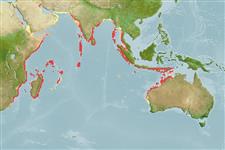Common names from other countries
>
Tetraodontiformes (Puffers and filefishes) >
Balistidae (Triggerfishes)
Etymology: Melichthys: Greek, melas, melaina, melan, black + icthys yos, fish. On the other hand, in Smith et al.,1986: 878), 'body dark brown to black' in https://www.biodiversitylibrary.org/item/266635#page/902/mode/1up.(P. Romero, pers.comm. 03/2022)..
More on authors: Randall & Klausewitz.
Environment: milieu / climate zone / depth range / distribution range
Ecología
marino asociado a arrecife; rango de profundidad 1 - 30 m (Ref. 9710). Tropical
Indian Ocean: Red Sea and East Africa eastward to western Thailand and Indonesia.
Tamaño / Peso / Age
Maturity: Lm ? range ? - ? cm
Max length : 25.0 cm TL macho / no sexado; (Ref. 4420)
Short description
Claves de identificación | Morfología | Morfometría
Espinas dorsales (total) : 3; Radios blandos dorsales (total) : 30 - 35; Espinas anales: 0; Radios blandos anales: 27 - 30. Narrow white margin round caudal fin; live specimens bluish or violet (Ref. 4420).
Inhabits coral-rich seaward reef slopes (Ref. 9710, 48637). Occurs singly (Ref. 9710). Digs holes below coral bases for shelter (Ref. 48637). Feeds on sponges, algae, crustaceans and small invertebrates (Ref. 5503). Caught with artisanal gear (Ref. 30573). Minimum depth from Ref. 58018.
Life cycle and mating behavior
Maturities | Reproducción | Spawnings | Egg(s) | Fecundities | Larva
Oviparous, distinct pairing during breeding (Ref. 205).
Smith, M.M. and P.C. Heemstra, 1986. Balistidae. p. 876-882. In M.M. Smith and P.C. Heemstra (eds.) Smiths' sea fishes. Springer-Verlag, Berlin. (Ref. 4420)
IUCN Red List Status (Ref. 130435)
CITES (Ref. 128078)
Not Evaluated
Threat to humans
Harmless
Human uses
Pesquerías: comercial; Acuario: Comercial
Herramientas
Special reports
Download XML
Fuentes de Internet
Estimates based on models
Preferred temperature (Ref.
115969): 25.4 - 29.3, mean 28.2 (based on 947 cells).
Phylogenetic diversity index (Ref.
82804): PD
50 = 0.6250 [Uniqueness, from 0.5 = low to 2.0 = high].
Bayesian length-weight: a=0.02570 (0.01232 - 0.05364), b=2.94 (2.77 - 3.11), in cm Total Length, based on LWR estimates for this (Sub)family-body shape (Ref.
93245).
Nivel trófico (Ref.
69278): 3.0 ±0.29 se; based on food items.
Resiliencia (Ref.
120179): Alto, población duplicada en un tiempo mínimo inferior a 15 meses (Preliminary K or Fecundity.).
Fishing Vulnerability (Ref.
59153): Low vulnerability (15 of 100).
